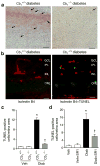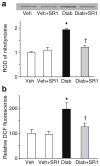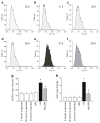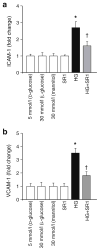Cannabinoid 1 receptor activation contributes to vascular inflammation and cell death in a mouse model of diabetic retinopathy and a human retinal cell line
- PMID: 21373835
- PMCID: PMC3375271
- DOI: 10.1007/s00125-011-2061-4
Cannabinoid 1 receptor activation contributes to vascular inflammation and cell death in a mouse model of diabetic retinopathy and a human retinal cell line
Abstract
Aims/hypothesis: Recent studies have demonstrated that cannabinoid-1 (CB(1)) receptor blockade ameliorated inflammation, endothelial and/or cardiac dysfunction, and cell death in models of nephropathy, atherosclerosis and cardiomyopathy. However the role of CB(1) receptor signalling in diabetic retinopathy remains unexplored. Using genetic deletion or pharmacological inhibition of the CB(1) receptor with SR141716 (rimonabant) in a rodent model of diabetic retinopathy or in human primary retinal endothelial cells (HREC) exposed to high glucose, we explored the role of CB(1) receptors in the pathogenesis of diabetic retinopathy.
Methods: Diabetes was induced using streptozotocin in C57BL/6J Cb(1) (also known as Cnr1)(+/+) and Cb(1)(-/-) mice aged 8 to 12 weeks. Samples from mice retina or HREC were used to determine: (1) apoptosis; (2) activity of nuclear factor kappa B, intercellular adhesion molecule 1 (ICAM-1), vascular cell adhesion molecule 1 (VCAM-1), poly (ADP-ribose) polymerase and caspase-3; (3) content of 3-nitrotyrosine and reactive oxygen species; and (4) activation of p38/Jun N-terminal kinase/mitogen-activated protein kinase (MAPK).
Results: Deletion of CB(1) receptor or treatment of diabetic mice with CB(1) receptor antagonist SR141716 prevented retinal cell death. Treatment of diabetic mice or HREC cells exposed to high glucose with SR141716 attenuated the oxidative and nitrative stress, and reduced levels of nuclear factor κB, ICAM-1 and VCAM-1. In addition, SR141716 attenuated the diabetes- or high glucose-induced pro-apoptotic activation of MAPK and retinal vascular cell death.
Conclusions/interpretation: Activation of CB(1) receptors may play an important role in the pathogenesis of diabetic retinopathy by facilitating MAPK activation, oxidative stress and inflammatory signalling. Conversely, CB(1) receptor inhibition may be beneficial in the treatment of this devastating complication of diabetes.
Conflict of interest statement
Figures








Similar articles
-
Ischaemia-induced retinal neovascularisation and diabetic retinopathy in mice with conditional knockout of hypoxia-inducible factor-1 in retinal Müller cells.Diabetologia. 2011 Jun;54(6):1554-66. doi: 10.1007/s00125-011-2081-0. Epub 2011 Mar 1. Diabetologia. 2011. PMID: 21360191 Free PMC article.
-
Cannabinoid 1 receptor promotes cardiac dysfunction, oxidative stress, inflammation, and fibrosis in diabetic cardiomyopathy.Diabetes. 2012 Mar;61(3):716-27. doi: 10.2337/db11-0477. Epub 2012 Feb 7. Diabetes. 2012. PMID: 22315315 Free PMC article.
-
CB1 cannabinoid receptors promote oxidative/nitrosative stress, inflammation and cell death in a murine nephropathy model.Br J Pharmacol. 2010 Jun;160(3):657-68. doi: 10.1111/j.1476-5381.2010.00769.x. Br J Pharmacol. 2010. PMID: 20590569 Free PMC article.
-
Endothelial Dysfunction in Diabetic Retinopathy.Front Endocrinol (Lausanne). 2020 Sep 4;11:591. doi: 10.3389/fendo.2020.00591. eCollection 2020. Front Endocrinol (Lausanne). 2020. PMID: 33013692 Free PMC article. Review.
-
The Role of Endothelial Senescence in the Pathogenesis of Diabetic Retinopathy.Int J Mol Sci. 2025 May 29;26(11):5211. doi: 10.3390/ijms26115211. Int J Mol Sci. 2025. PMID: 40508021 Free PMC article. Review.
Cited by
-
Retinal endothelial cell apoptosis.Apoptosis. 2012 Dec;17(12):1258-60. doi: 10.1007/s10495-012-0777-3. Apoptosis. 2012. PMID: 23143137 Free PMC article. Review.
-
Role of the endocannabinoid system in diabetes and diabetic complications.Br J Pharmacol. 2016 Apr;173(7):1116-27. doi: 10.1111/bph.13226. Epub 2015 Aug 20. Br J Pharmacol. 2016. PMID: 26076890 Free PMC article. Review.
-
Endocannabinoids in aqueous humour of patients with or without diabetes.BMJ Open Ophthalmol. 2020 Feb 17;5(1):e000425. doi: 10.1136/bmjophth-2019-000425. eCollection 2020. BMJ Open Ophthalmol. 2020. PMID: 32154372 Free PMC article.
-
Targeting cannabinoid signaling for peritoneal dialysis-induced oxidative stress and fibrosis.World J Nephrol. 2017 May 6;6(3):111-118. doi: 10.5527/wjn.v6.i3.111. World J Nephrol. 2017. PMID: 28540200 Free PMC article. Review.
-
A Potential Involvement of Anandamide in the Modulation of HO/NOS Systems: Women, Menopause, and "Medical Cannabinoids".Int J Mol Sci. 2020 Nov 20;21(22):8801. doi: 10.3390/ijms21228801. Int J Mol Sci. 2020. PMID: 33233803 Free PMC article.
References
Publication types
MeSH terms
Substances
Grants and funding
LinkOut - more resources
Full Text Sources
Medical
Molecular Biology Databases
Research Materials
Miscellaneous

